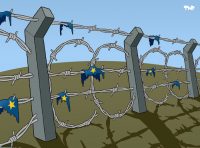 The article that we report has been published by Sbilanciamoci.info within the collection ‘Gli speciali di Sbilanciamoci‘: a series of discussions about the anniversary of the Treaties of Rome. In particular, this article is part of the thematic section on Fortress Europe.
The article that we report has been published by Sbilanciamoci.info within the collection ‘Gli speciali di Sbilanciamoci‘: a series of discussions about the anniversary of the Treaties of Rome. In particular, this article is part of the thematic section on Fortress Europe.
Deconstructing the mantra of ”unsustainable humanitarian emergency“, from which we should try to defend ourselves with the militarization of borders, it is one of the first things to do for those who still believe that it’s possible to save Europe. The certainties about the future of the European Union are very few or, on the other hand, the White Paper recently published by the European Commission and the rumours about the contents of the Rome Declaration that the Heads of State and Governments will be asked to sign on the 25th of March, they offer a particularly illuminating guidance.
However, something is certain. And it would be better if it were not.
Assuming that the French presidential elections will not lead to an acceleration of the disintegration of the Union, whatever is the political mediation that will prevail at the end of the 60th year of the signature of the Treaties of Rome, it will have as a priority the strengthening of cooperation in the defence sector (in research, industrial policy and the common procurement management), internal security (through improved coordination between national police forces) and the external border control in order to limit the migrant arrivals (whether “economic” or asylum seekers) through an operation of a European border coast guard, and through the development of return programs of “irregular” migrants and a targeted and selective cooperation with third countries.
The reading of the White Paper on the future of Europe leaves no doubt: all hypothetical “scenarios” “for the evolution of Europe by now until 2025”, a part the latter one that only provides for the maintenance of a single market, imagine a European Union militarized and protected by external borders, increasingly difficult to cross. [1]
The text of the Rome Declaration, still under revision, not explicitly opt for any of the routes outlined by the Commission, but security and governance of migration policies are one of the four pillars of the document cited by the Chairman of Gentiloni Council in Brussels.
The governance solution that seems possible, to get the signature of even the recalcitrant countries of Visegrad Group, is one that renounces explicit assumption of the German proposal of “two-speed Europe”, without excluding separate hypotheses collaboration in various areas of intervention. “We will act together whenever possible, with different rhythms and intensities, where necessary, as we have done in the past within the framework of the Treaties and leaving the door open to those who wish to join later. Our Union is undivided and indivisible. ” This is the formula needed to reach agreement on the text, according to rumors in the press. [2]
Migration and asylum: the refusal as a lowest common denominator
Just the government of migration and the movement of people within the Union are one of the main points of crisis of the European integration process. There are at least three distinct perspectives and political strategies that currently divide Europe.
The first is the Northern countries, which are in a better economic situation, have welfare systems and generally more efficient hospitality, for many years they tried to stop the economic migration from third countries, but they left open the doors to asylum seekers, at least until the humanitarian crisis linked to the degeneration of the Syrian situation. The parenthesis, quickly closed, the unilateral suspension of the Dublin Regulation on the German side in 2015, forms part of a strategy that identifies as a priority the blocking of migration from third countries, but also a restriction on the free circulation within ‘Union. The results of the referendum on Brexit have in fact been accompanied by initiatives, for example in Germany, designed to restrict access to the welfare of EU citizens from other member states.
The countries located to the outer southern borders, most directly affected by migration flows from the Southern Mediterranean, but also with less efficient systems of welfare and hospitality, are more interested in a “supportive” cooperation with other member countries, sharing “BUSINESS burden” and outplacement programs invoked by the European Migration, remained largely unimplemented. The same countries are even those who continue to “export” its most qualified citizens in the countries of Northern Europe and are interested in maintaining the free movement of persons within the European Union.
At the end Eastern European countries directly involved in the crisis that followed all opening of the Balkan Route, have closed their doors to external migration, erecting walls and barbed wires along their borders, but, being still countries of emigration toward the central and Western Europe, are interested in maintaining the free internal movement of persons.
Economic and social situations and different models of welfare and reception systems very different from each other contribute in order to bring together these three different perspectives solely on the refusal policies: strengthening the control of land and sea borders, asylum procedures more restrictive detention of migrants without residence permits, forced returns accelerated in countries of origin, international cooperation folded objective of the migration block. And ‘This is the direction you are moving the EU institutions and the nationals. The blindness of Fortress Europe between old and new nationalism “The various changes taking place in the world and the genuine sense of insecurity felt by many to have led to a growing disaffection towards traditional politics and institutions at all levels, which is often manifested in the form of indifference and lack of confidence in the work of public authorities and also creates a vacuum that is filled with too much ease as populist and nationalistic rhetoric. “[ 3]
This reading of the consensus growing that parties and nationalist movements, populist and xenophobic are having in many European countries, proposed by the Commission, without any mention of self-critical with Community policies introduced until today.
There is the dull resignation to the hegemony of the political and institutional debate on the fate of Europe on the part of the right. For sometime now, but in a marked way from the campaign for the European elections of 2014 and after the entry of Trump on the political scene, euroscepticism, nationalism, xenophobia and racism are intertwined, largely escaping from the traditional sphere of influence of the far-right movements.
That was possible due to agitation instrumental and rhetorical arguments that can find an easy consensus in public. The evocation of the crisis and the decline of Europe is easily leveraging the economic and social hardship of large segments of the European population. The complaint of a widespread “perception of insecurity” draws nourishment from the disorientation caused by the resumption of jihadist attacks in Europe. Xenophobia and racism can ride the inability of European and national institutions to manage in a non-emergency growth in arrivals of asylum seekers, waving the issue of unsustainable migration to the welfare systems and national labor. Xenophobia and racism actually allow you to combine the theme of the crisis and the insecurity and produce a perfect scapegoat: the foreign migrants, potential enemies ( “criminal/terrorist”), competing with European citizens in the labor market and in welfare. This can happen due to a large removal operated much to those who govern us at EU and national level, as xenophobic-racist movements: that of the failed economic and social policies pursued to date and those migratory and on asylum. Nor are the coming men and women the cause of the European crisis, if anything, are the most defenseless victims. And the securitarian approach comes from far away, it went through the entire history of the European integration process and has already amply demonstrated to have failed. Deconstructing the mantra of ” unsustainable humanitarian emergency “, which should defend itself with the militarization of borders, the proliferation of detention centers everywhere and “humanitarian” missions against traffickers, is one of the first things to do for those who still believe that it is possible to save Europe. And the key issue is not that what equality.
[1] See: https://ec.europa.eu/commission/sites/beta-political/files/libro_bianco_sul_futuro_dell_europa_it.pdf
[2] See: http://www.lastampa.it/2017/03/17/esteri/prima-marcia-indietro-sullue-a-due-velocit-inaccettabile-uneuropa-di-serie-a-e-una-di-b-gyqCAtH8dWlqoNakGdXlQI/pagina.html
[3] White Paper of the European Commission, see page 12


